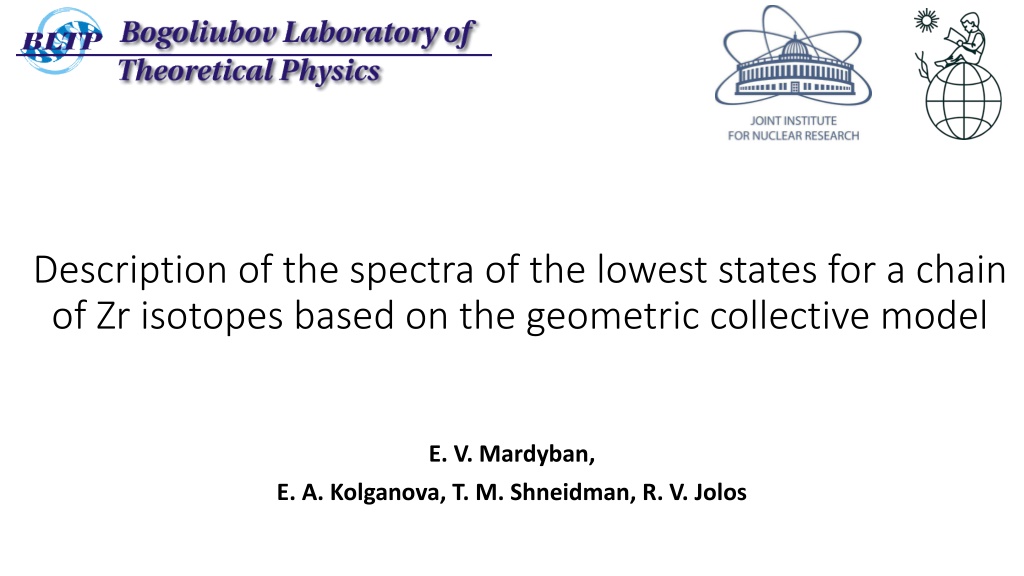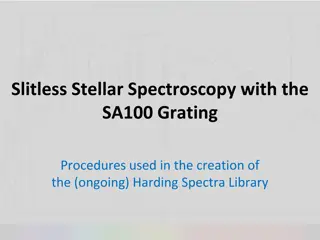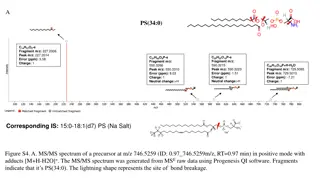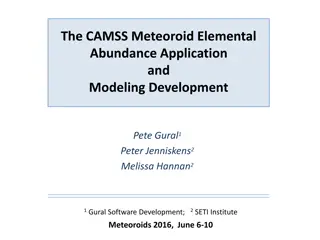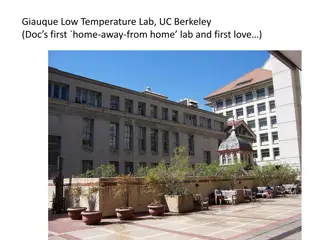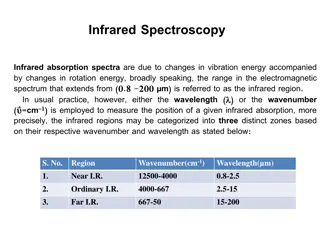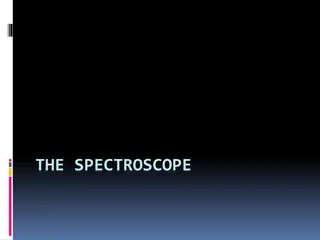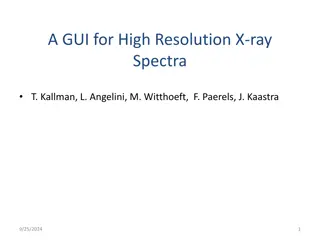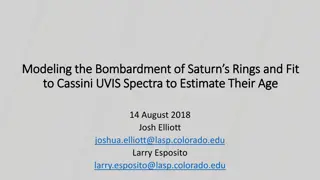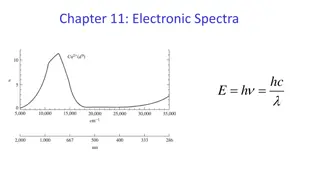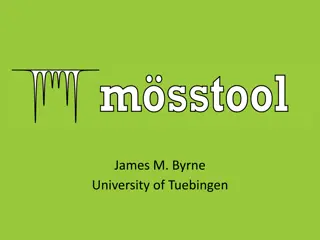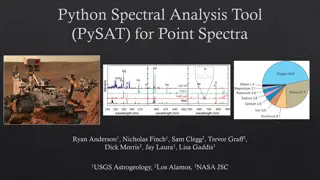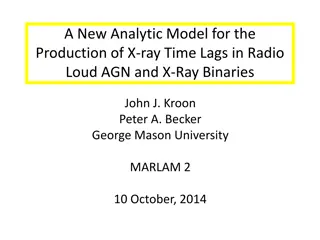Description of the spectra of the lowest states for a chain
The evolution of shape in Zr isotopes is analyzed using the geometric collective model, revealing transitions between spherical and deformed shapes with configurations mixing. The collective quadrupole Bohr Hamiltonian is employed, with deformation parameters determining the nucleus's shape. The study explores the probabilities of electromagnetic transitions and the coexistence of different nuclear forms, highlighting the purity in 96Zr. Various types of deformation and potential energy evolution are discussed, providing insights into the lowest states of Zr isotopes.
Download Presentation

Please find below an Image/Link to download the presentation.
The content on the website is provided AS IS for your information and personal use only. It may not be sold, licensed, or shared on other websites without obtaining consent from the author.If you encounter any issues during the download, it is possible that the publisher has removed the file from their server.
You are allowed to download the files provided on this website for personal or commercial use, subject to the condition that they are used lawfully. All files are the property of their respective owners.
The content on the website is provided AS IS for your information and personal use only. It may not be sold, licensed, or shared on other websites without obtaining consent from the author.
E N D
Presentation Transcript
Description of the spectra of the lowest states for a chain of Zr isotopes based on the geometric collective model E. V. Mardyban, E. A. Kolganova, T. M. Shneidman, R. V. Jolos
Introduction The evolution of the shape can occur with a smooth or abrupt transition from a spherical to a deformed shape, and there can be a strong or weak mixing of configurations with different shapes. Such information is contained in the probabilities of electromagnetic transitions, and a high purity of coexisting forms was established in96Zr C. Kremer et al. Phys. Rev. Lett. 117, 172503 (2016)
Model The collective quadrupole Bohr Hamiltonian including axial degree of freedom can be written as : Types of collective motion described by the Bohr Hamiltonian It depends on two deformation parameters ? and ?, which are the coefficients of the expansion of the radius of the nucleus Each coefficient is responsible for a specific shape of the nucleus. The ? is responsible for the deviation from the spherical shape. The ? is responsible for compressing and stretching. Nucleus surface shapes of various types of deformations T. Niksic, Z.P. Li, D. Vretenar, L. Prochniak, J. Meng, and P. Ring, Phys.Rev. C 79, 034303 (2009) N. Gavrielov and A. Leviatan, Phys.Rev. C 99, 064324 (2019).
Model 6 6 3 3 E (MeV) E (MeV) 0 0 -3 -3 0,0 0,1 0,2 0,3 0,4 0,5 0,0 0,1 0,2 0,3 0,4 0,5 b b Evolution of one dimensional potential energy without shape coexistence Evolution of one dimensional potential energy with shape coexistence A. Poves, J.Phys. G: Nucl. Part. Phys. 43, 024010 (2016). K. Heyde, J.L. Wood, Rev.Mod.Phys. 83, 1467 (2011). J.L. Wood, K. Heyde, W. Nazarewich, M. Huyse, and P.V. Duppen, Phys. Rep. 215, 101 (1992). K. Heyde, P. Van Isacker, M. Waroquier, J.L. Wood, and R.A.Meyer, Phys. Rep., 102, 291 (1983).
Model We define a potential energy in the form 60 8 50 8 7 40 6 6 6 30 5 E (MeV) 4 4 20 3 2 10 2 2 0,8 0 0 0,0 0,1 0,3 0,2 0,4 0,0 0,1 0,2 0,3 0,4 0,5 b Influence of the ? addiction J.E. Garcia-Ramos and K. Heyde, Phys.Rev. C 43, 044315 (2019).
Results 96Zr 92Zr 94Zr 60 60 60 g g g 50 50 10 50 10 10 9 9 9,3 40 40 40 8 8 8,6 7 7 30 30 7,9 30 6 6 7,2 5 5 6,5 20 20 20 4 4 5,8 3 3 5,1 10 10 2 10 2 4,4 1 1 3,7 0 0 0 0 0 3,0 0,1 0,2 0,3 b 0,5 0,0 0,4 0,2 0,4 0,6 0,0 0,1 0,3 b 0,5 0,2 0,0 0,1 0,4 0,3 b 10 10 10 9 9 9 8 8 8 7 7 7 6 6 6 E (MeV) E (MeV) E (MeV) 5 5 5 4 4 4 3 3 3 2 2 2 1 1 1 0,0 0,1 0,2 0,3 b 0,4 0,5 0,6 0,0 0,1 0,2 0,3 b 0,4 0,5 0,6 0,0 0,1 0,2 0,3 b 0,4 0,5 0,6 Calculated potential surfaces for Zr isotopes and cuts at ? = 0. E. V. Mardyban, E. A. Kolganova, T. M. Shneidman, R. V. Jolos, and N. Pietralla. Phys. Rev. C 102, 034308 (2020) D.A. Sazonov, E.A. Kolganova, T.M. Shneidman, R.V. Jolos, N.Pietralla, and W. Witt, Phys.Rev. C 99, 031304(R) (2019).
Results 100Zr 98Zr 102Zr 60 60 g g 60 50 g 1,0 50 6,0 50 8 0,50 5,4 40 8 40 40 0,0 7 4,8 7 -0,50 30 4,2 30 30 6 -1,0 3,6 6 -1,5 3,0 5 20 20 20 -2,0 5 2,4 4 -2,5 1,8 4 10 10 10 -3,0 1,2 3 -3,5 3 0,60 0 0 -4,0 2 0 0,0 0,2 0,3 0,4 0,0 0,1 0,0 0,1 0,4 0,5 0,2 0,3 b 0,4 0,5 0,0 0,1 0,2 0,3 b 0,6 b 10 10 5 9 9 4 3 8 8 2 7 7 1 6 6 E (MeV) E (MeV) E (MeV) 5 5 0 -1 4 4 -2 3 3 -3 2 2 -4 1 1 -5 0,0 0,1 0,2 0,3 b 0,4 0,5 0,6 0,0 0,1 0,2 0,3 b 0,4 0,5 0,6 0,0 0,1 0,2 0,3 b 0,4 0,5 0,6 Calculated potential surfaces for Zr isotopes and cuts at ? = 0. E. V. Mardyban, E. A. Kolganova, T. M. Shneidman, R. V. Jolos, and N. Pietralla. Phys. Rev. C 102, 034308 (2020) D.A. Sazonov, E.A. Kolganova, T.M. Shneidman, R.V. Jolos, N.Pietralla, and W. Witt, Phys.Rev. C 99, 031304(R) (2019).
Results 140 7 7 B(2_1->0_1)exp B(4_1->2_1)exp B(2_1->0_1) B(4_1->2_1) E0_1exp E2_1exp E4_1exp E6_1exp E0_1 E2_1 E4_1 E6_1 E8_1 E0_2exp E2_2exp E4_2exp E6_2exp E0_2 E2_2 E4_2 E6_2 E8_2 120 6 6 100 5 5 BE2 (W.u.) E (MeV) E (MeV) 80 4 4 60 3 3 40 2 2 20 1 1 0 0 0 92 94 96 98 100 102 92 94 96 98 100 102 92 94 96 98 100 102 A A A Calculated (lines) and experimental (dots) energies of the first excited states with angular momentum 0, 2, 4, and 6 Calculated (lines) and experimental (dots) energies of the ground states with angular momentum 0, 2, 4 and 6 Calculated (lines) and experimental (dots) values of the probabilities of quadrupole transitions between the lowest states of the ground band Experimental data taken from https://www.nndc.bnl.gov/ensdf/
Conclusion - The spectra of the lowest states of the chain of zirconium isotopes are described based on the geometric collective model. Good agreement with experimental data for excitation energies and E2 transition probabilities was obtained. - - It was shown that in the evolution of potential energy there is a phenomenon of shape coexistence. - There are some deviations for isotopes close to the spherical region due to the specifics of the used model. - The presented results are preliminary and will be further improved. Thank you for attention! The main results of previous works are included in E. V. Mardyban, E. A. Kolganova, T. M. Shneidman, R. V. Jolos, and N. Pietralla, Phys. Rev. C 102, 034308 (2020) D.A. Sazonov, E.A. Kolganova, T.M. Shneidman, R.V. Jolos, N.Pietralla, and W. Witt, Phys. Rev. C 99, 031304(R) (2019)
